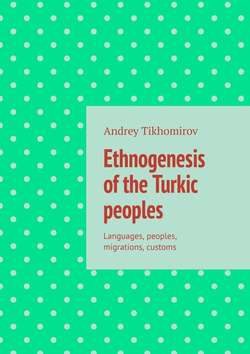Ethnogenesis of the Turkic peoples. Languages, peoples, migrations, customs

Реклама. ООО «ЛитРес», ИНН: 7719571260.
Оглавление
Andrey Tikhomirov. Ethnogenesis of the Turkic peoples. Languages, peoples, migrations, customs
Migration of Turkic peoples
Turkic languages
Customs, traditions, rites, rituals of Turkic peoples
Briefly in Azerbaijani
Briefly in Bashkir
Briefly in Chuvash
Briefly in Kazakh
Briefly in Kyrgyz
Briefly in Tatar
Briefly in Turkish
Briefly in Uzbek
References
Отрывок из книги
In the process of development of Turkic languages and peoples – their carriers, dialects and languages were formed, characterized, on the one hand, by similarities – as a result of the unity of their origin, and on the other – by differences, which are explained by the collapse of the common Turkic base language, first into dialects, and then into separate languages and groups of languages. Turkic peoples are formed on a vast space in the Altai Mountains and interact with other language groups of peoples: Mongolian, Tunguso-Manchu and Tibetan-Chinese. The word “Altai” itself goes back to the Turkic word “altyn” – “gold”, in Mongolian “alt”. “Altan tobchi” or “Altan tovch” (“golden button” or “golden vault”) is the Mongolian annals of the 17th century. Since ancient times, Altai is famous for its rich deposits of polymetals, iron ore, mercury, as well as gold.
The Turki of Altai subjugated tribes and peoples of various origins, including non-Turkic. Authority, as written sources indicate, was concentrated in the hands of the tribal nobility, which had accumulated huge herds of cattle, looted property and had slaves in its economy. At the head of this feudal-patriarchal association was the kagan. However, among the Altai Turks and peoples subordinate to them the tribal tribe, in many respects still primitive social organization, remained and classes in the modern sense did not exist yet. The state was just an unstable association of related tribes with the same development of the economy.
.....
Many scholars considered the Huns a model of “pure” nomads. But new archaeological materials and a careful study of Han (Chinese) written sources showed that not only the Huns, but also their ancestors built fortified cities. After the Hunish state split, it was the Western Huns under the pressure of the Eastern, that is, the ancestors of the Mongols, in the II century BC. e. moved west with their religion and after mixing with the Scythian tribes (female Amazonian priestly communities, the Amazonian from the Greek “breastless”, removed one woman’s breast so that she could better fight and kill the enemy, only after that she could get married) and the Ugrian population in the second half of the 4th century became known in European historiography as the Huns. Following them, during another great migration of peoples in the early Middle Ages, various peoples descended from the same regions from the crossbreeding of Indo-Europeans, Indo-Iranians, Iranians with local Finnish tribes: Kipchaks (Polovtsy) from Altai and a conglomerate of other ethnic groups named in the VI century the Chinese “tyukyu”, and the Europeans – “Turki”. For many millennia, nomadic life has proven to be the most stable. He provided tremendous military advantages. The nomadic world must be seen as something fluid. Unlike settled peoples, the nomadic people could easily get away from the blow of the enemy army. For nomads, it’s just their way of life. For the enemy army, moving across the steppe without settlements and the availability of agriculture is a problem. The nomadic world, based entirely on the principle of nomadism, is adapted to overcome land spaces. Of course, there were clashes between sedentary and nomadic peoples, which was reflected in the Bible in the conflict between Abel and Cain. Nomads could not exist without a settled population, they needed clothes, weapons, and these are the results of the labor of farmers and artisans, that is, a settled population.
At the first alarm, the nomads threw everything, and women, children and the elderly were taken in wagons, later they tried to leave them protected by reliable fortifications, if possible. Such a way of life was preserved among the peoples of the southern Russian steppes, who led a nomadic and semi-nomadic way of life, and after a thousand years, of which Batu organized detachments along the border strips to protect the borders. They were called the Turkic word “Cossack.” One of the first references to the term “Cossack” in Muslim written sources is found in an anonymous Turkic-Arabic dictionary, probably compiled in Egypt, known from the manuscript of 1245 with the meaning “homeless”, “homeless”, “wanderer”, “exile”. It is known that until Catherine II, correspondence with the Cossacks was conducted in Turkic (Tatar), that is, in their official language, as evidenced by letters preserved in the archives.
.....